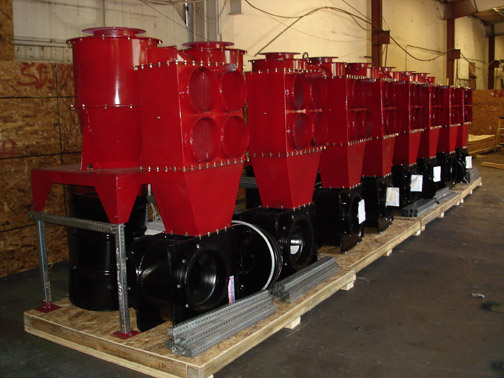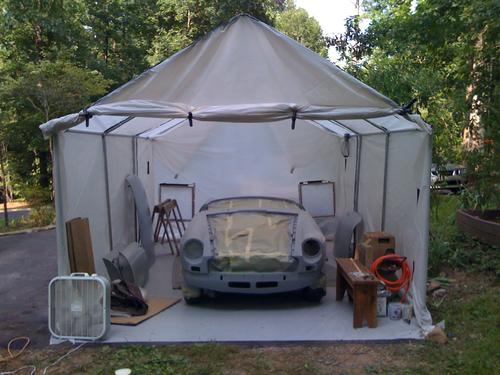 NFPA-33 spray application for combustible or flammable materials is authored by the National Fire Protection Association and is regarded as the top-level standard for spray booth design, use and maintenance. This booklet is available through various online sites (e.g. www.techstreet.com) for under $50. It is used by all spray booth manufacturers in the USA and should be owned by anyone using a spray booth. It is full of information based on past issues. Standard Tools and Equipment also refers to OSHA 29CFR1910 and IFC codes to influence spray booth design, materials and manufacturing.
NFPA-33 spray application for combustible or flammable materials is authored by the National Fire Protection Association and is regarded as the top-level standard for spray booth design, use and maintenance. This booklet is available through various online sites (e.g. www.techstreet.com) for under $50. It is used by all spray booth manufacturers in the USA and should be owned by anyone using a spray booth. It is full of information based on past issues. Standard Tools and Equipment also refers to OSHA 29CFR1910 and IFC codes to influence spray booth design, materials and manufacturing.
Continue reading Canadian Paint Booth Standards
Tag: OSHA
Manufactured vs. Homemade Paint Booths
We all love a handyman, a professional who can fix anything. And not just any handyman, we want the best handyman. When our pipes burst, we call the plumber. When our cars break down, we call the mechanic. So why would you try to make a homemade paint booth?
Whenever you are dealing with highly volatile products such as paint and chemicals there is the possibility of fire or the risk of an explosion. This is why homemade paint booths are not quite the route to take. Of course they are cheaper, and that is exactly the quality you will get. Dealing with something as serious as mixing harmful chemicals, a topnotch manufactured paint booth is required to keep you safe. Homemade Booths rarely, if ever, meet NFPA 33 and OSHA codes.
Many homemade paint booths have no ventilation system. A paint booth is essentially a sealed area with a powerful fan or air circulation unit installed in it. Your circulation unit should be powerful enough to circulate all the air in the room every five minutes to prevent the buildup of fumes. Both the inflow and the outflow vents should be equipped with air filters. A non-ventilated paint booth may be decent for painting small objects such as a dice; however, when painting big projects like car parts, your breathing is in trouble.
Manufactured paint booth systems are more pleasant, less likely to cause painting problems and a whole lot less likely to blow you to Kingdom Come! The technology is available to keep you alive. At Standard Tools, your safety is number one on our list. Our booths are quality to keep you safe and will not damage your pockets. Everyone wants to have quality and save money at the same time. Let Standard Tools do that for you.
INDUSTRY HAZARD: COMBUSTIBLE DUST
Tracy Beach, Plant Manager
Standard Tools and Equipment Co.
 Combustible dust was to blame for 348 explosions, 793 injuries, and 133 deaths from 1980 to 2008. It is a terrifying hazard that goes overlooked in many facilities because it is not fully understood. Are you taking all the precautions necessary to ensure that your shop, and your employees, are safe?
Combustible dust was to blame for 348 explosions, 793 injuries, and 133 deaths from 1980 to 2008. It is a terrifying hazard that goes overlooked in many facilities because it is not fully understood. Are you taking all the precautions necessary to ensure that your shop, and your employees, are safe?
“Dust becomes fuel for fires and explosions when it builds to hazardous levels,” noted Standard Tools and Equipment’s plant manager, Tracy Beach. “Sources such as sugar, flour, feed, plastics, wood, rubber, furniture, textiles, pesticides, pharmaceuticals, dyes, coal, and metals can form combustible dust.”
The Occupational Safety and Health Administration (OSHA) show some of the materials that may become explosive when divided into small enough particles here (PDF).
There is a directive intended to reduce the occurrence of explosions and fire due to combustible dust. OSHA has launched the Combustible Dust National Emphasis Program (or Combustible Dust NEP) to administer safety requirements and fines where there currently is no code. Immediate action is to identify findings and impose fines on companies that have combustible dust that is not being managed or not managed adequately. The long-term action is to develop a suitable requirement. Click here to read more information about Dust NEP.
Standard Tools and Equipment provides cyclone dust collectors, cartridge filter systems and spray booths designed specifically for powder coating. These items are designed to meet, or exceed, the National Fire Protection Association (NFPA) and OSHA requirements.
Our suggestion is for your safety team to review the processes for handling or creating combustible dust and to call us at 1-800-451-2425 if you find that combustible dust is a concern for you.
If you have combustible dust, you will need processes and equipment to handle it. Please do not wait until after a catastrophe or visit from your OSHA inspector. Dust is an item that is much less expensive to handle before any such event occurs.


